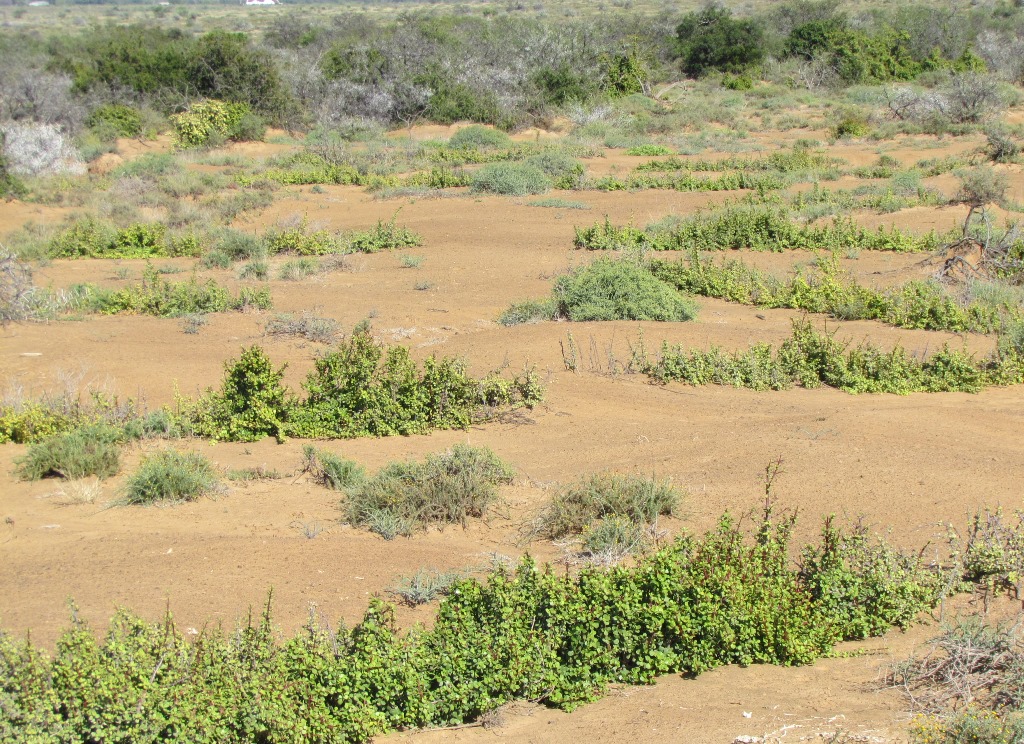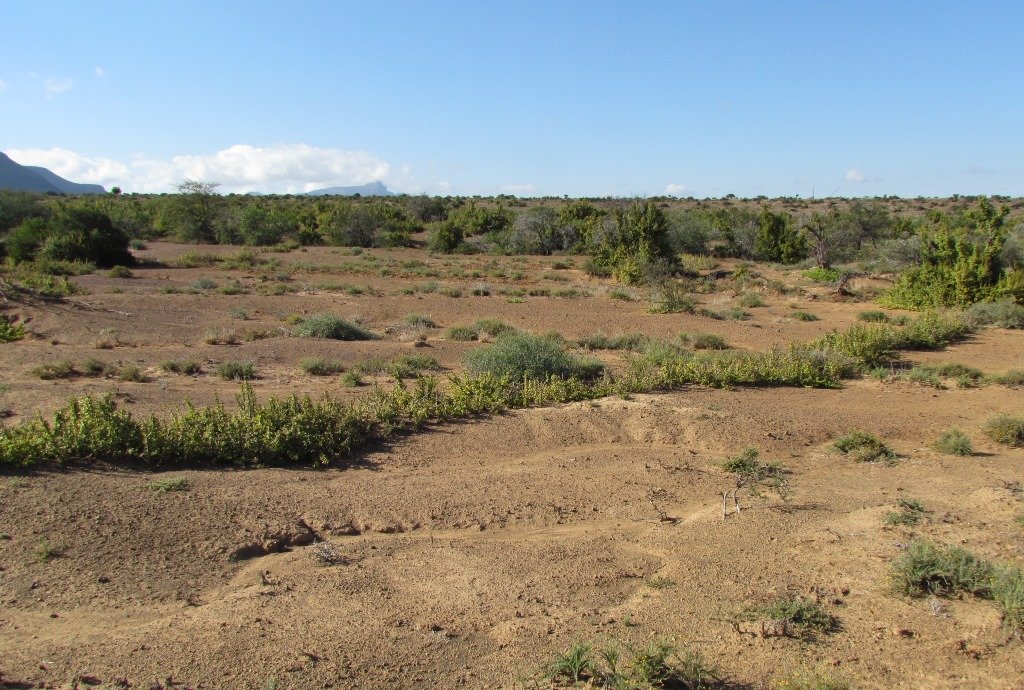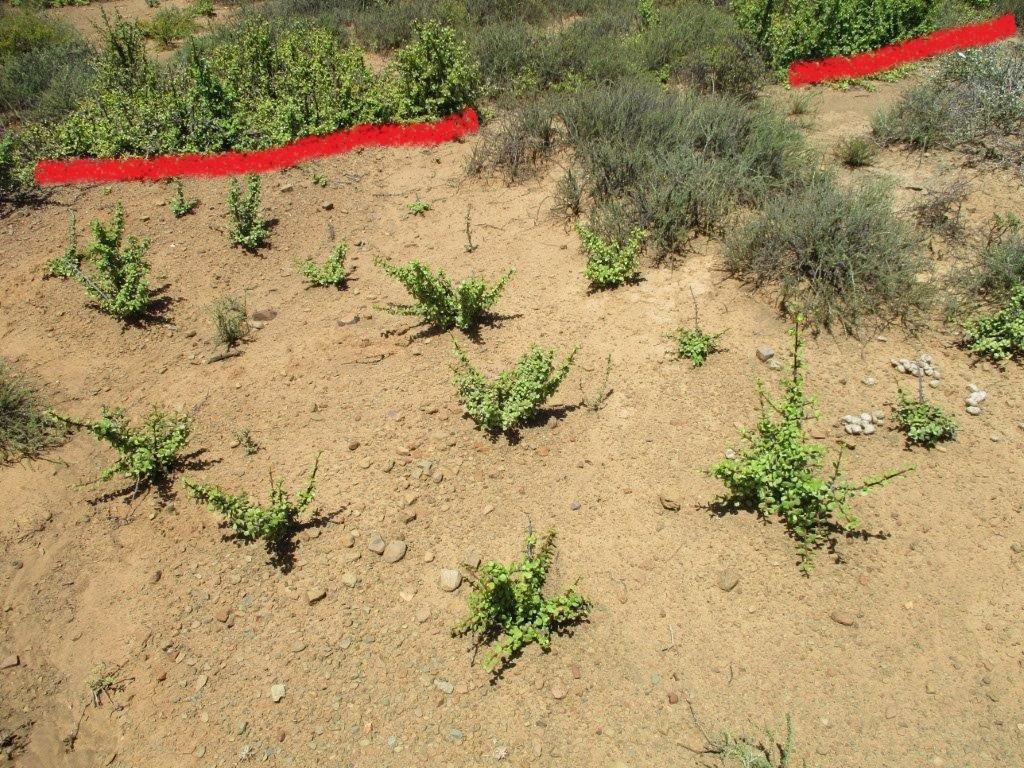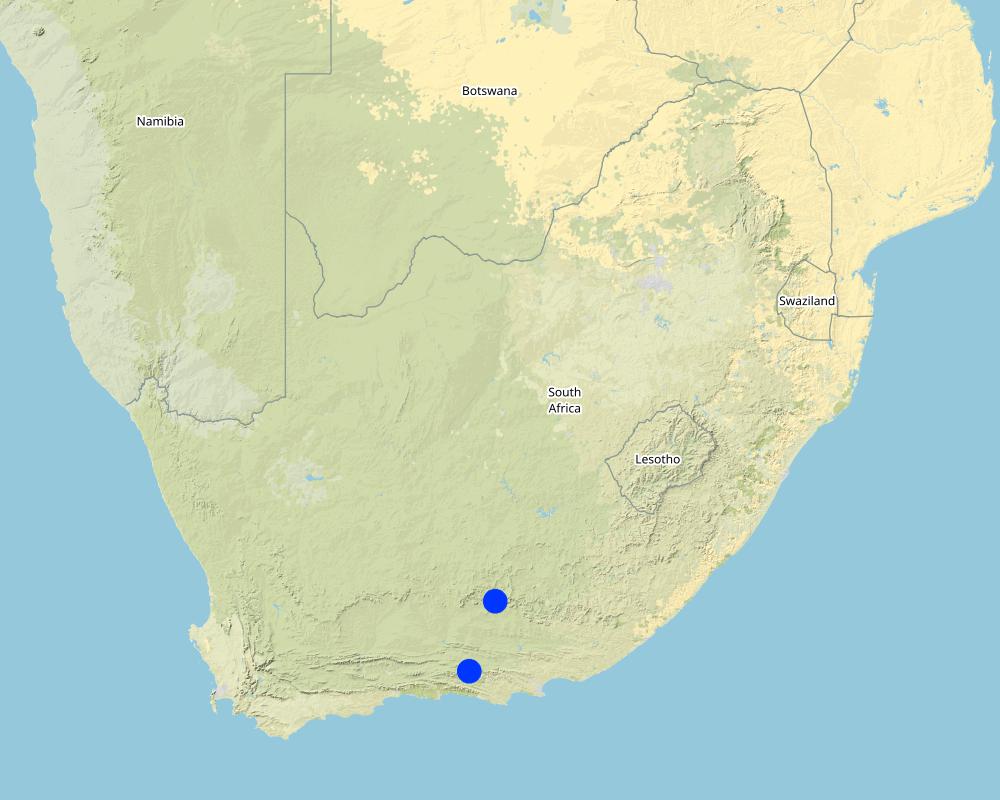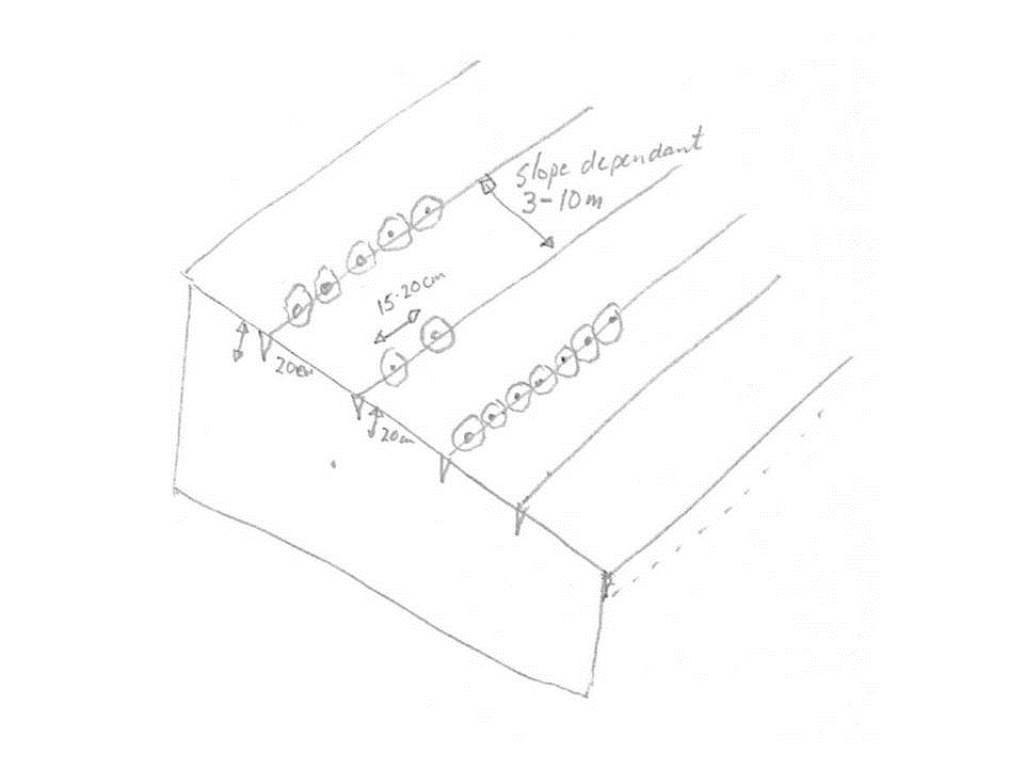Spekboom (Portulacaria afra) planting within riplines for thicket biome restoration [南非]
- 创建:
- 更新:
- 编制者: Dirk Pretorius
- 编辑者: –
- 审查者: Alexandra Gavilano, Rima Mekdaschi Studer, Maximilian Knoll, Yacime Khadraoui, Joana Eichenberger
Spekboom planting on contours
technologies_3614 - 南非
- Spekboom (Portulacaria afra) planting within riplines for thicket biome restoration: May 19, 2018 (inactive)
- Spekboom (Portulacaria afra) planting within riplines for thicket biome restoration: June 20, 2019 (inactive)
- Spekboom (Portulacaria afra) planting within riplines for thicket biome restoration: Nov. 2, 2021 (public)
查看章节
全部展开 全部收起1. 一般信息
1.2 参与该技术评估和文件编制的资源人员和机构的联系方式
有助于对技术进行记录/评估的项目名称(如相关)
Working on Ecosystems (Natural Resource Management Programmes – DEA, South Africa)有助于对技术进行记录/评估的项目名称(如相关)
Book project: Guidelines to Rangeland Management in Sub-Saharan Africa (Rangeland Management)有助于对技术进行记录/评估的机构名称(如相关)
SMC Synergy (SMC Synergy) - 南非1.3 关于使用通过WOCAT记录的数据的条件
编制者和关键资源人员接受有关使用通过WOCAT记录数据的条件。:
是
1.4 所述技术的可持续性声明
这里所描述的技术在土地退化方面是否存在问题,导致无法被认为是一种可持续的土地管理技术?:
否
1.5 参考关于SLM方法(使用WOCAT记录的SLM方法)的调查问卷
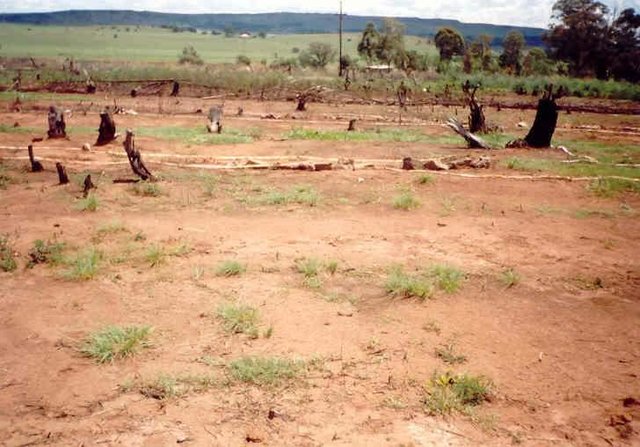
Working for Water [南非]
Government funded restoration/rehabilitation initiative as part of Working for Water project. Aim was to eradicate alien invasive.
- 编制者: Klaus Kellner
2. SLM技术的说明
2.1 技术简介
技术定义:
The restoration of the thicket biome in the Eastern Cape is assisted by planting ‘spekboom’ (elephant bush) (Portulacaria afra), an indigenous succulent plant within contour lines/riplines on degraded hillslopes. The increased vegetation cover reduces runoff and soil loss.
2.2 技术的详细说明
说明:
Due to severe land degradation over many decades of goat farming, the restoration of the so-called ‘thicket biome’ is taking place on a large scale in the Baviaanskloof Nature Reserve and Camdeboo National Park in the Eastern Cape of South Africa. The restoration projects have been introduced in parts of the thicket biome that receive 350 to 500 mm annual average rainfall. The main direct cause of degradation is overgrazing/browsing by goats (Boer and Angora) over the past 100 years. The overutilization of vegetation occurs mainly on valley bottoms and footslopes in mountainous areas where relatively fertile soils occur. This has resulted in large expanses of open vegetation canopy under which a high degree of runoff occurs - and subsequent soil loss leading to increased sediment loads in downstream drainage systems. The thicket biome vegetation (especially spekboom) is well known for its ability to sequester large amounts of carbon and therefore help towards mitigating climate change. The improved vegetation cover also contributes towards an increase in biodiversity, and therefore has a positive impact on tourism also. Establishment of spekboom in riplines can be used in combination with other technologies e.g. brush packing (laying cut bush on the soil surface), silt fences (low barriers across the slope) or fibre rolls. This technology can be employed in any similar semi-arid environment to restore degraded catchments - using locally appropriate plant species.
After identification of sites to be rehabilitated, this is followed by the identification of suitable sources of plant material for transplantation at the rehabilitation areas. In the case of the project in the Eastern Cape, spekboom cuttings of 30 to 50 cm in length were taken from existing stands, then left for one to two weeks in the sun to dry slightly before being transplanted in the rehabilitation sites. Care must be taken not to over-harvest healthy spekboom stands - not more than 30% should be removed.
Riplines need to be created along the contour by means of mechanisation or manual labour. Riplines should be between 3 and 10 meter apart - depending on the slope (closer on steep slopes) - 10 to 20 cm deep and just wide enough to plant the spekboom cuttings to a depth of at least 10 cm. Cuttings are planted between 15 to 20 cm apart within the ripline, so as to form a continuous barrier/sediment trap along the contour. The ripline promotes water infiltration into the rootzone of the cuttings. Cuttings need to be firmed-in with soil dug from the ripline. Watering the spekboom after planting is recommended – if possible. Brush packing (brush packing with thorny biomass to prevent grazing and provide a micro-climate for grass seed to germinate and establish) between riplines with local woody material (if available locally, and preferably thorny branches) is recommended to provide protection against grazing and to create a micro-climate for vegetation growth. In between riplines, silt fences or fibre rolls can be used to slow water runoff and to trap sediment. Maintenance includes the replanting of cuttings where mortality occurred.
2.3 技术照片
2.5 已应用该技术的、本评估所涵盖的国家/地区/地点
国家:
南非
区域/州/省:
Eastern Cape
具体说明该技术的分布:
- 适用于特定场所/集中在较小区域
注释:
Only implemented on degraded Thicket Biome areas on low to moderate slopes.
Map
×2.6 实施日期
注明实施年份:
2010
如果不知道确切的年份,请说明大概的日期:
- 不到10年前(最近)
2.7 技术介绍
详细说明该技术是如何引入的:
- 在实验/研究期间
注释(项目类型等):
Research conducted by P Burdett at Camdeboo National Park.
3. SLM技术的分类
3.1 该技术的主要目的
- 减少、预防、恢复土地退化
- 保护生态系统
- 结合其他技术保护流域/下游区域
- 保持/提高生物多样性
- 适应气候变化/极端天气及其影响
- 减缓气候变化及其影响
- 创造有益的经济影响
3.2 应用该技术的当前土地利用类型

牧场
- Wildlife in nature reserves
- Various game species
注释:
Main animal species and products: Various game species.
Number of growing seasons per year: 1
Livestock density: Only wildlife - low density
3.4 供水
该技术所应用土地的供水:
- 雨养
3.5 该技术所属的SLM组
- 改良的地面/植被覆盖
- 集水
- 地表水管理(泉、河、湖、海)
3.6 包含该技术的可持续土地管理措施

植物措施
- V1:乔木和灌木覆盖层

结构措施
- S6:墙、障碍物、栅栏、围墙
3.7 该技术强调的主要土地退化类型

土壤水蚀
- Wt:表土流失/地表侵蚀
- Wg:冲沟侵蚀/沟蚀
- Wo:场外劣化效应

物理性土壤退化
- Pc:压实
- Pk:熟化和结壳
- Pi:覆土

生物性退化
- Bc:植被覆盖的减少
- Bh:栖息地丧失
- Bq:数量/生物量减少

水质恶化
- Hs:地表水良变化
- Hg:地下水/含水层水位的变化
- Hp:地表水水质下降
3.8 防止、减少或恢复土地退化
具体数量名该技术与土地退化有关的目标:
- 修复/恢复严重退化的土地
注释:
Overgrazing by goats over the past 100 years – land has been purchased from private landowners since 1987.
4. 技术规范、实施活动、投入和成本
4.1 该技术的技术图纸
技术规范(与技术图纸相关):
Spekboom cuttings (30 - 50 cm in length and 1 to 3 cm diameter) are cut from existing stands. The riplines are created by labourer (soil on downhill side of line) on contours with the spacing between lines a function of the slope (3 metres apart on 10 - 15 degree slopes and 6 to 10 metres apart on 5 to 10 degree slopes). The cuttings are planted 15 to 20 cm apart in the riplines at a depth of around 10 cm.
Riplines 10cm deep – as long as the bare patches that need rehabilitation – labourers also use picks.
作者:
J Buckle
日期:
21/02/2018
4.2 有关投入和成本计算的一般信息
具体说明成本和投入是如何计算的:
- 每个技术区域
注明尺寸和面积单位:
1 ha
其它/国家货币(具体说明):
Rand
如相关,注明美元与当地货币的汇率(例如1美元=79.9巴西雷亚尔):1美元=:
12.0
注明雇用劳工的每日平均工资成本:
140
4.3 技术建立活动
| 活动 | 时间(季度) | |
|---|---|---|
| 1. | Creation of riplines (unskilled manual labour) | during wet season |
| 2. | Collection of Spekboom cuttings | during wet season |
| 3. | Transport of cuttings to planting site | during wet season |
| 4. | Planting of cuttings in riplines | during wet season |
| 5. | Watering of cuttings | during wet season |
4.4 技术建立所需要的费用和投入
| 对投入进行具体说明 | 单位 | 数量 | 单位成本 | 每项投入的总成本 | 土地使用者承担的成本% | |
|---|---|---|---|---|---|---|
| 劳动力 | Unskilled labour (including transport) | per day | 20.0 | 240.0 | 4800.0 | 100.0 |
| 设备 | Picks, spades, wheel barrow, bow saw and pruning shears (renting equipment) | per day | 20.0 | 20.0 | 400.0 | 100.0 |
| 植物材料 | Planting material is free | |||||
| 植物材料 | Planting material is free | |||||
| 其它 | Management (including transport) | per day | 2.0 | 600.0 | 1200.0 | 100.0 |
| 技术建立所需总成本 | 6400.0 | |||||
| 技术建立总成本,美元 | 533.33 | |||||
4.5 维护/经常性活动
| 活动 | 时间/频率 | |
|---|---|---|
| 1. | Replant cuttings where mortality occurs | 6 to 8 months after planting |
4.6 维护/经常性活动所需要的费用和投入(每年)
| 对投入进行具体说明 | 单位 | 数量 | 单位成本 | 每项投入的总成本 | 土地使用者承担的成本% | |
|---|---|---|---|---|---|---|
| 劳动力 | Replanting of cuttings (unskilled labour - including transport) | per day | 10.0 | 240.0 | 2400.0 | 100.0 |
| 其它 | Management (including transport) | per day | 1.0 | 600.0 | 600.0 | 100.0 |
| 技术维护所需总成本 | 3000.0 | |||||
| 技术维护总成本,美元 | 250.0 | |||||
4.7 影响成本的最重要因素
描述影响成本的最决定性因素:
Soil hardness, labour cost and distance to rehabilitation site.
5. 自然和人文环境
5.1 气候
年降雨量
- < 250毫米
- 251-500毫米
- 501-750毫米
- 751-1,000毫米
- 1,001-1,500毫米
- 1,501-2,000毫米
- 2,001-3,000毫米
- 3,001-4,000毫米
- > 4,000毫米
指定年平均降雨量(若已知),单位为mm:
350.00
有关降雨的规范/注释:
Summer thunderstorms
农业气候带
- 半干旱
Harsh hot summers and very cold winters
5.2 地形
平均坡度:
- 水平(0-2%)
- 缓降(3-5%)
- 平缓(6-10%)
- 滚坡(11-15%)
- 崎岖(16-30%)
- 陡峭(31-60%)
- 非常陡峭(>60%)
地形:
- 高原/平原
- 山脊
- 山坡
- 山地斜坡
- 麓坡
- 谷底
垂直分布带:
- 0-100 m a.s.l.
- 101-500 m a.s.l.
- 501-1,000 m a.s.l.
- 1,001-1,500 m a.s.l.
- 1,501-2,000 m a.s.l.
- 2,001-2,500 m a.s.l.
- 2,501-3,000 m a.s.l.
- 3,001-4,000 m a.s.l.
- > 4,000 m a.s.l.
说明该技术是否专门应用于:
- 凸形情况
5.3 土壤
平均土层深度:
- 非常浅(0-20厘米)
- 浅(21-50厘米)
- 中等深度(51-80厘米)
- 深(81-120厘米)
- 非常深(> 120厘米)
土壤质地(表土):
- 中粒(壤土、粉土)
- 细粒/重质(粘土)
土壤质地(地表以下> 20厘米):
- 中粒(壤土、粉土)
表土有机质:
- 低(<1%)
5.4 水资源可用性和质量
地下水位表:
> 50米
地表水的可用性:
匮乏/没有
水质(未处理):
仅供农业使用(灌溉)
水的盐度有问题吗?:
是
具体说明:
High sodium content in the parent sedimentary rock
该区域正在发生洪水吗?:
是
5.5 生物多样性
物种多样性:
- 中等
栖息地多样性:
- 中等
5.6 应用该技术的土地使用者的特征
其它(具体说明):
Government conservation areas
生产系统的市场定位:
- 商业/市场
非农收入:
- > 收入的50%
相对财富水平:
- 平均水平
个人或集体:
- 员工(公司、政府)
机械化水平:
- 手工作业
性别:
- 女人
- 男人
土地使用者的年龄:
- 青年人
- 中年人
说明土地使用者的其他有关特征:
Rehabilitation mainly on State-owned conservation areas - can be replicated on private land.
5.7 应用该技术的土地使用者使用的平均土地面积
- < 0.5 公顷
- 0.5-1 公顷
- 1-2 公顷
- 2-5公顷
- 5-15公顷
- 15-50公顷
- 50-100公顷
- 100-500公顷
- 500-1,000公顷
- 1,000-10,000公顷
- > 10,000公顷
这被认为是小规模、中规模还是大规模的(参照当地实际情况)?:
- 大规模的
5.8 土地所有权、土地使用权和水使用权
土地所有权:
- 州
土地使用权:
- 社区(有组织)
- Conservation areas
- Conservation areas
5.9 进入服务和基础设施的通道
健康:
- 贫瘠
- 适度的
- 好
教育:
- 贫瘠
- 适度的
- 好
技术援助:
- 贫瘠
- 适度的
- 好
就业(例如非农):
- 贫瘠
- 适度的
- 好
市场:
- 贫瘠
- 适度的
- 好
能源:
- 贫瘠
- 适度的
- 好
道路和交通:
- 贫瘠
- 适度的
- 好
饮用水和卫生设施:
- 贫瘠
- 适度的
- 好
金融服务:
- 贫瘠
- 适度的
- 好
6. 影响和结论性说明
6.1 该技术的现场影响
社会经济效应
生产
饲料生产
饲料质量
社会文化影响
娱乐机会
SLM/土地退化知识
生态影响
水循环/径流
水量
水质
水的回收/收集
地表径流
土壤
土壤水分
土壤覆盖层
土壤流失
土壤有机物/地下C
生物多样性:植被、动物
植被覆盖
栖息地多样性
减少气候和灾害风险
洪水影响
碳和温室气体的排放
微气候
6.2 该技术的场外影响已经显现
下游洪水
下游淤积
温室气体的影响
对场外影响(测量)的评估进行具体说明:
The cumulative effect of large areas planted with Spekboom will have a huge offsite impact especially after a few years.
6.3 技术对渐变气候以及与气候相关的极端情况/灾害的暴露和敏感性(土地使用者认为的极端情况/灾害)
渐变气候
渐变气候
| 季节 | 增加或减少 | 该技术是如何应对的? | |
|---|---|---|---|
| 年温度 | 增加 | 好 | |
| 年降雨量 | 减少 | 适度 |
气候有关的极端情况(灾害)
气象灾害
| 该技术是如何应对的? | |
|---|---|
| 局地雷暴 | 非常好 |
| 局地雹灾 | 不好 |
气候灾害
| 该技术是如何应对的? | |
|---|---|
| 寒潮 | 不好 |
水文灾害
| 该技术是如何应对的? | |
|---|---|
| 山洪暴发 | 适度 |
生物灾害
| 该技术是如何应对的? | |
|---|---|
| 流行病 | 不好 |
6.4 成本效益分析
技术收益与技术建立成本相比如何(从土地使用者的角度看)?
短期回报:
轻度消极
长期回报:
积极
技术收益与技术维护成本/经常性成本相比如何(从土地使用者的角度看)?
短期回报:
轻度消极
长期回报:
积极
6.5 技术采用
- 1-10%
在所有采用这项技术的人当中,有多少人是自发的,即未获得任何物质奖励/付款?:
- 0-10%
6.6 适应
最近是否对该技术进行了修改以适应不断变化的条件?:
是
其它(具体说明):
Improved planting techniques
具体说明技术的适应性(设计、材料/品种等):
Planting of cuttings with established roots from the mother plant and creation of small notches a the cutting to stimulate root growth.
6.7 该技术的优点/长处/机会
| 土地使用者眼中的长处/优势/机会 |
|---|
| A long-term cost-effective technique to rehabilitate badly degraded thicket vegetation. |
| Creates temporary work for poor local communities. |
| Reduces sediment load in streams and rivers. |
| 编制者或其他关键资源人员认为的长处/优势/机会 |
|---|
| Spekboom sequesters large quantities of carbon and therefore contributes over the long term to climate change mitigation. |
| Downstream benefits on water quality. |
6.8 技术的弱点/缺点/风险及其克服方法
| 土地使用者认为的弱点/缺点/风险 | 如何克服它们? |
|---|---|
| Labour intensive - not viable if not subsidised by Government. | Reduce manual labour - mechanise the creation of riplines. |
| Newly established spekboom stands vulnerable to browsing. | Fence rehabilitated areas. |
| Newly established spekboom stands vulnerable to drought and frost. | Timing of planting in wet/warm season |
7. 参考和链接
7.1 信息的方法/来源
- 与SLM专业人员/专家的访谈
1
(现场)数据是什么时候汇编的?:
21/02/2018
7.3 链接到网络上的相关信息
标题/说明:
Spekboom foundation
URL:
http://www.spekboomfoundation.co.za/about.html
链接和模块
全部展开 全部收起链接

Working for Water [南非]
Government funded restoration/rehabilitation initiative as part of Working for Water project. Aim was to eradicate alien invasive.
- 编制者: Klaus Kellner
模块
无模块


